3 Oldsmobiles from the brand’s youthful, exuberant heyday
You probably remember the “Not your father’s Oldsmobile” ads that debuted in 1988 in an attempt to promote the company’s updated front-wheel drive lineup and turn around a precipitous drop in sales. Even as a school-age kid, those 30-second spots fell flat for me. I understood that the sleek new W-body Cutlass was more advanced than my grandma’s late ’70s rusty brown car of the same name, but not my father’s Oldsmobile? Yes, these new cars were the antithesis of muscle, but the ground-pounding 4-4-2s and the occasional Hurst/Olds my dad would go out of his way to steer me toward at car shows were glorious. Why would a company would want to distance themselves from that? If anything, those cars were peak Oldsmobile.
Decades later, we know how well those ads worked. Olds is gone, and for many younger buyers, the name might as well be Studebaker or even Mercer—they just don’t see many classic Oldsmobiles, so it would be easy to consider the brand a dusty relic without fun or interesting models to enjoy.
This is, of course, quite wrong. Oldsmobile’s effort in the muscle car era yielded several eye-catching and entertaining alternatives to the Chevy/Ford/Dodge contingent, and they stand out even today.
1969 Hurst/Olds
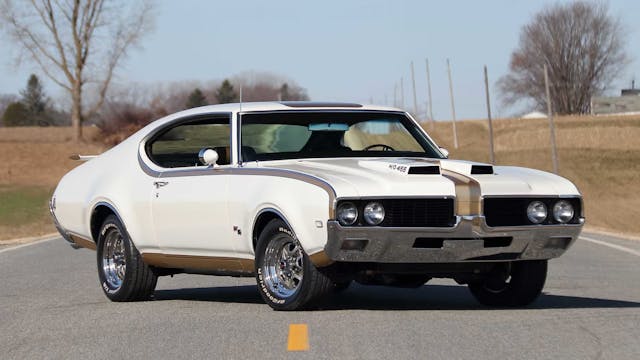
Sixties muscle car lore has no shortage of end-around stories—processes that enabled some truly fast and fun cars to come to life despite corporate edicts and other efforts to stymie the horsepower wars. Chevy’s COPO cars are perhaps the most notorious, but the Hurst/Olds deserves a special mention.
George Hurst had an idea. An inveterate hot rodder and creator of the shifter that bore his name, Hurst had established a strong relationship with GM in the early ’60s. In 1967, he approached Pontiac with a plan to get around the corporate ban on engine sizes of greater than 400 cubic inches in mid-size and smaller platforms: Hurst would install the Poncho 428-cubic inch V-8 into completed Firebirds and Pontiac would sell them at their dealerships. While conversations did make it up the ladder with some enthusiasm, the Pontiac deal fell short. Instead, Hurst was pointed to another GM brand that might have interest: Oldsmobile.
This time, the effort gained traction. Oldsmobile dearly wanted to update its image and drive sales of their 4-4-2, which was capable on the street but paled in comparison to Pontiac’s GTO on the sales charts. A Hurst/Olds halo car, with its engine bay filled with the new Oldsmobile 455-cubic inch V-8 while all the other mid-sized cars had to make do with GM’s 400-cube limit, appealed to Oldsmobile chief engineer John Beltz. Ultimately, even with the edict in place, the bigger engines were installed by Oldsmobile itself before the cars were delivered to Hurst for further modification.
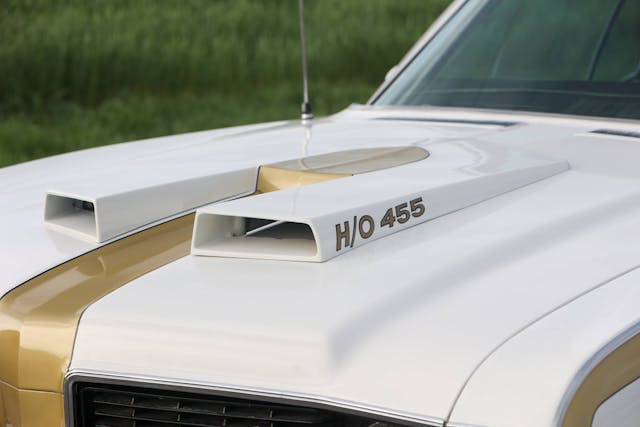
The Hurst/Olds debuted in 1968, but the 1969 model is more broadly remembered thanks to its more overt Firefrost Gold over Cameo white paint scheme and mailbox hood scoops wearing “H/O 455” in large gold lettering.
At 380 horsepower and an even 500 lb-ft of torque, the 455 in the ’69 Hurst/Olds didn’t disappoint, though it had 10 hp less than the non-AC models from 1968. Zero-to-60 took a brisk 6 seconds and the quarter mile went by in 14—not the top of the muscle car heap, but still plenty quick. The only option for shifting was the TH-400 three-speed automatic topped with, you guessed it, a Hurst shifter that had the standard pattern along with another gate that enabled shifting through the forward gears without the possibility of engaging park or reverse.
In addition to the engine, hood scoop, shifter, and hallmark color scheme, a large rear wing, special door mirrors, grey 15×7-inch wheels, Hurst/Olds emblems, and a registration dash plaque (provided when the original buyers sent in their information) completed the package. According to the Hurst/Olds Club of America, 906 ’69 Hurst/Olds were made, all of which were coupes except for three convertibles used by Hurst for promotional activity (other sources put that number at two).
Unlike many muscle cars, the Hurst/Olds did not see a value bump during the pandemic. It did, however, begin to see its values drop as the market began to cool in 2022. A #2 excellent condition car is valued at $63,500, while a #3 car comes in at $46,600, which sounds affordable compared with other rare muscle with similarly interesting history. Hagerty Price Guide editor Greg Ingold elaborates:
“The main downside is that they’re all equipped with automatics, which might be a detractor to non-Oldsmobile enthusiasts. Couple that with the fact that when Hurst/Olds come up for sale, they’re not often in show condition—a lot are driver-quality cars. That may drag the average down somewhat.”
1970 4-4-2 W-30
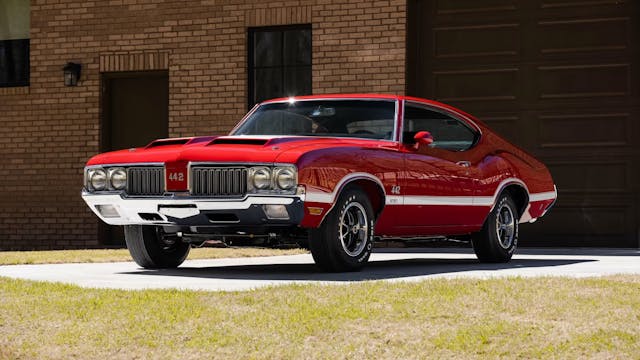
What a difference a year makes. The brass at GM finally decided to lift its engine displacement limitations for the 1970 model year, and suddenly Olds didn’t need the Hurst side door operation to fit the 455 into its A-body muscle car—it was now standard in the 4-4-2. As a result, the Hurst/Olds was shelved and the 4-4-2 with the W-30 package became the top dog with a healthy 370 horses and 500 lb-ft of torque, just shy of the the Hurst/Olds’ 380. Hurst wasn’t completely missing from the picture—buyers who opted for the TH 400 automatic got the dual-gate shifter (a heavy duty four-speed manual was also available).
The W-30 package consisted of quite a few engine tweaks given the five-horse advantage it held over the base 455—different heads, an aluminum intake manifold, and a unique camshaft were the primary changes. Though these engines didn’t wind out the tach, torque is the Olds 455’s calling card, and it had plenty of it.
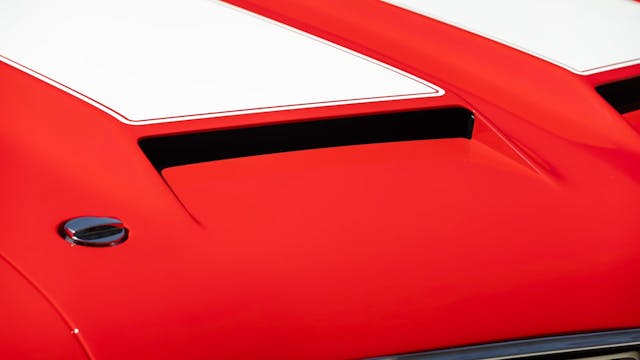
Other elements of the package include a dual-scoop fiberglass hood that leads air to a vacuum-actuated opening to the air cleaner, front disc brakes, and its handsome appearance elements. Though a cheaper car than the Hurst/Olds when new, the W-30 only fared nominally better than the Hurst/Olds in the sales department. 3100 ’70 W-30s were sold across three body styles, with only 264 convertibles produced.
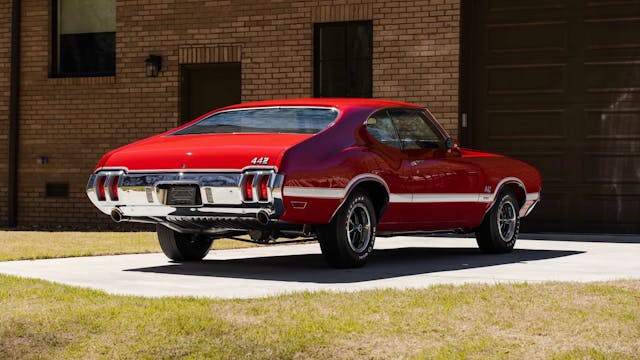
Today, despite the greater number of cars, lower horsepower rating, and less tantalizing backstory, the ’70 W-30 holds a commanding value advantage over the Hurst/Olds—#2 W-30s are almost 40 grand more expensive at $103,000, and good-condition driver values are just under $75,000. The W-30 enjoyed a dramatic bump during the pandemic, with #2 values cresting $130,000 in July of 2022 before settling just above pre-pandemic values in the last Price Guide.
1970 Cutlass Rallye 350

An outgrowth of the Hurst program though it was built in-house, the Cutlass Rallye 350 offered all the show (and then some) along with a portion of the go of its more muscular siblings. Debuting in 1970 and lasting only that model year, it’s not an overstatement to say that the Rallye 350 is one of most visually distinctive Oldsmobiles ever produced.
Even for the rainbow-hued colorful peak of the muscle car era, the Cutlass Rallye 350 wore a lot of yellow. The bumpers, typically chrome-plated, were instead urethane-coated and slathered in the same Sebring Yellow as the body, and the wheels eschewed the usual chrome trim rings for full effect. Shiny bits trimmed the glass and grille, and strokes of black decals along its flanks and hood scoops added definition to the car’s lines—those are the only concessions to the car’s otherwise completely sunny disposition.
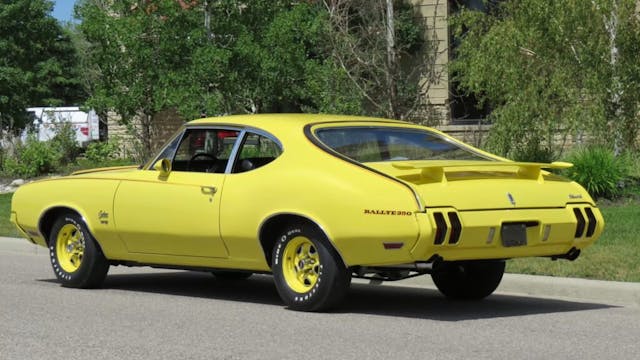
As attention-getting as its exterior was, the Rallye 350 wasn’t going to win many races, but it wasn’t a boat anchor, either. At 310 hp and 390 lb-ft of torque, the 350-cubic inch L74 engine was powerful enough to ensure that buyers wouldn’t be embarrassed on the street while also avoiding big-block-level insurance premiums. Transmission options included three- and four-speed manuals as well as the Turbo Hydra-Matic 350 three-speed automatic, and the differential had optional “Anti-Spin,” Olds’ term for limited slip, and 3.23-, 3.42-, or 3.91:1 gear sets. Optimally set up, the Rallye 350 would find 60 in seven seconds and run the quarter in the low 15-second range.
Whether buyers weren’t sure what to do with such a flashy car from a typically staid company, or there was a lack of understanding of how to promote this mid-range muscle car, the Rallye 350 didn’t fare well on the sales floor—only 3547 units were produced. Modern buyers can expect to pay about 50 grand for an excellent example, while a good driver can be had for under $35,000. The Rallye 350 saw a significant bump in value in 2021 and has remained stable since then.
It turns out that I may not have been the only one who had a family member who shared with them how cool these cars could be. Millennials are showing interest in their father’s (or is it their grandfather’s?) Oldsmobiles, with a significant 22 percent share among Cutlass buyer (the Rallye 350 is categorized with the Cutlass). That their portion of 4-4-2 ownership is slightly less makes sense given that car’s higher values. Gen X represents about a third of Cutlass and 4-4-2 buyers, while boomers continue to hold strong in both. Though values are flat for the Rallye 350 and trending down for the Hurst/Olds and ’70 W-30, interest among younger buyers appears to be significant enough to suggest that Olds muscle will continue to remain a popular, if slightly niche, alternative option in the segment.
Oldsmobile struggled with its image, on and off, for decades. From performance V-8 trailblazer in the ’50s, to a reputation as an old person’s car in the ’60s before these A-body muscle cars arrived, to a sales leader, to an old person’s car yet again before its death as a brand in 2004, the company nonetheless did have some great and characterful efforts. The Hurst/Olds, W-30, and Rallye 350 represented a shining moment for the brand. Which of these three would you pick?
***
Check out the Hagerty Media homepage so you don’t miss a single story, or better yet, bookmark it. To get our best stories delivered right to your inbox, subscribe to our newsletters.
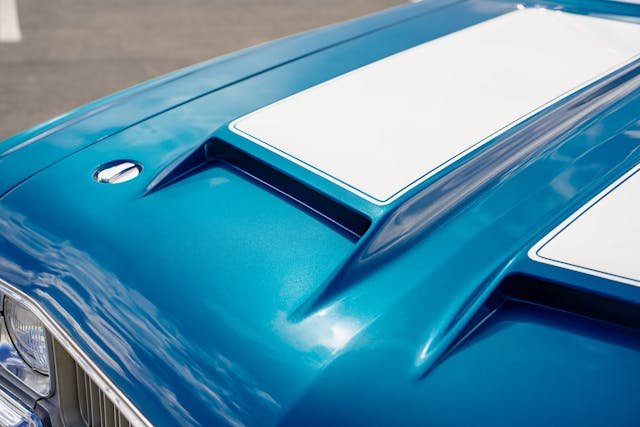

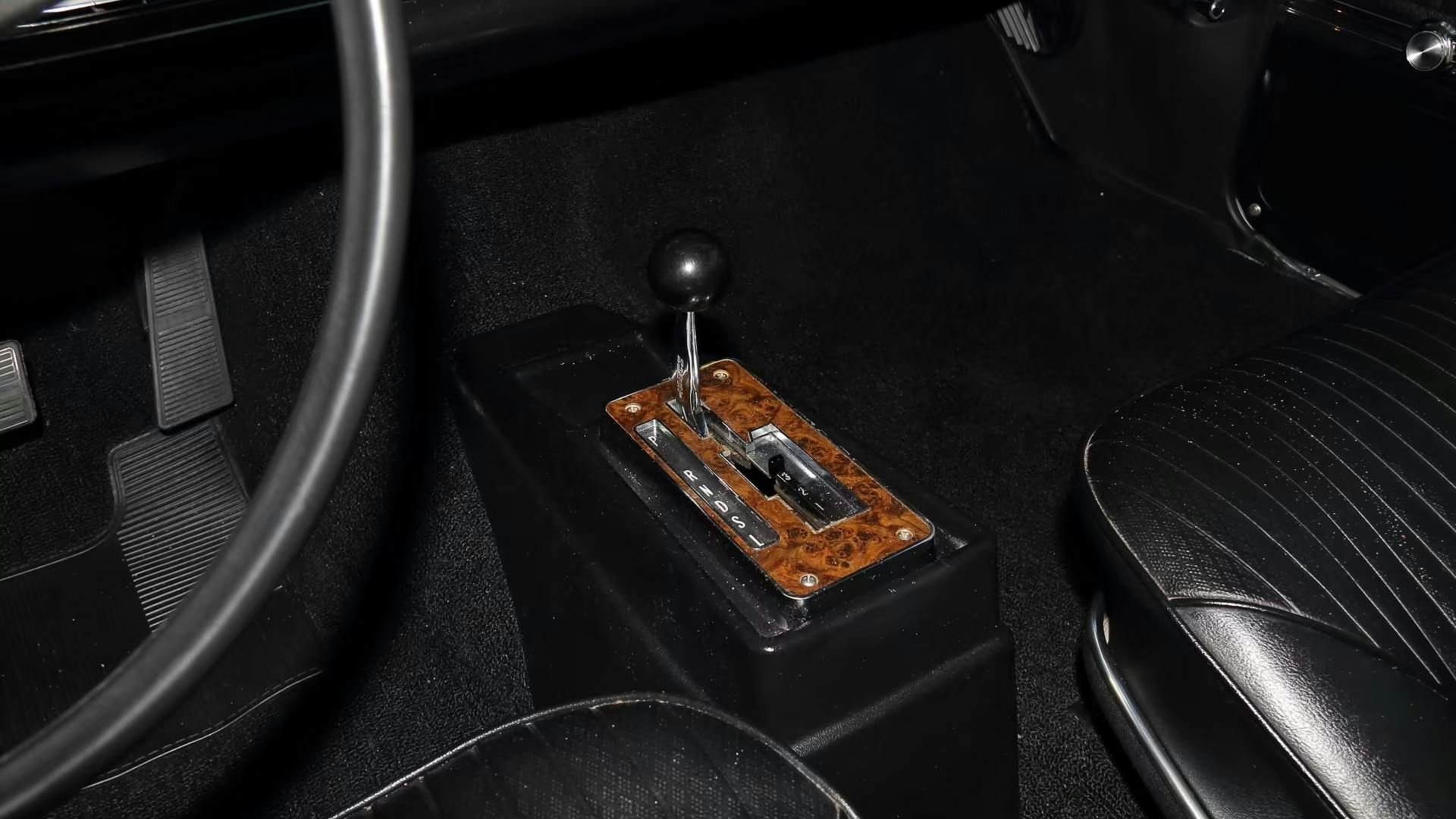


“She was made for straightaways. Grew up hatin’ Chevrolets. She’s a Rocket. She was made to burn.”
Never had the money for the “fancy “ Oldsmobiles but built several F-85’s that were very competitive. Had a 69 Vista Cruiser that was a beast between stop lights. Oldest son drove it to high school. Didn’t worry about the Camaros and Mustangs. Lol
3 very nice cars!
In 1980, my friend bought a 1970 W30 convertible 4 speed, triple green. He paid $7,500 Cdn. A new Z28 was $12,000
Our 2 barrel cars with 4 barrels installed were childs play compared to that.
It did the biggest burn out ever seen up to that day.
A neighbor in the Indianapolis “projects” turned a gold VistaCruiser into a 442 clone, hood w/pins, Hurst His’n’Hers shifter/console, emblems, and a rippin’ built W30 based 455. This was in 1974, when one could buy a station wagon new. I loved that thing, fake woodgrain and all. Had the most awesome, low frequency lumpy idle, dude never had to turn more than 4000 rpm to make his point. Used to take us project kids to the drive in to see things like “Two Lane Blacktop”, “Gone in 60 Seconds” (original), and Hammer Studios horror (“Dracula Has Risen From The Grave” and such). He preferred Cragar S/S rims over the Olds Ralleys, and the Gabriel HiJackers certainly compromised the ride… but cool doesn’t need comfort, and kids in the “wayback” like that bounciness. I know, I was there.
I briefly had a 442 convertible. It was rotting away in the back yard of a house up the road and I had been asking the owner to sell it for years but he wanted way too much money for a car with the convertible top caved into the interior. The guy moved and left the car behind, and the new owners heard that I had been asking about it and pushed it into my backyard parking area without my knowledge. I inquired about the title and they didn’t have it or any contact info for the owner. I ended up passing it along to the owner of a junk yard who I imagine knows how to get lost titles. It was like being the dog who caught the car. Even if I had the title, it was probably a bit beyond my capabilities at the time to get that car going again.
Sad story
Glad you mention the “trail blazing 50s V8s”. Rocket 88 = midsize mass market model with high spec v8… predates Duntov selling Corvette parts to basic Chev customers and predecessor to GTO.
Olds was a huge sales success in the 70s though. Cutlasses were great in that era too, and of the Colonnade era are one of the best designs that stands up now (especially if you restmod the Brougham off it –sorry Mr. Klockau).
For years I have thought GM should do a “My father’s Cutlass, my mother’s cutlass, my nanna’s Cutlass…” ad campaign based around a logical evolution of the 70s Cutlass look (pretty much all the retro look stuff from that fad were smoothy blobby versions of the old style and/or bloated. –this could be boxy but smaller scale than the 73-76 look). It can be a Chevy Cutlass and do a thing about “passing the torch to keep the legend alive” or whatever.
My mom had a 1970’s Cutlass in maroon with tan interior. It looked the part of a ‘mom’s car.’ But. It had a V8 and went like crazy during a decade when everything was slow and terrible. What a cool car.
Dude in highschool back around ’78-’79, showed up at the Steak-n- Shake in one of those ’69 Hurst Olds. Didn’t take long and he was known to be able to put others in their place. ’70 396 SS Camaro, ’69 Z/28 (mine),a ’73 mach one and a GTS Dart to name a few victims of the power of that Olds. We all went back and forth on cruise night,but that Hurst Olds definitely could run with the big dogs. Heck it was one, just not as well known. Its bite could back up it’s bark….. Just Badass….
Yeah, like he said, “There was a lot more going on under the hood than the 5 hp difference seemed to indicate”. Those 455 W-motors were a genuine big cube big block that was built for durability, and their long stroke, while not making them high revving, gave the pistons a leverage advantage at mid stroke that made torque in obscene amounts across a very wide rpm range that started about fast idle speed! I had a 1969 Dodge Super Bee with a 335 hp 383 and an A833 4 spd w/Hurst pistol grip. Ran pretty good and I knew how to launch it right. I rarely lost running between stoplights. One night, a rather unassuming Cutlass in gray primer lined up next to me and completely embarrassed me. He was ahead of me at least 5 car lengths before we had even gone 1/8 mile and pulling away fast when I saw a bunch of sparks and commotion under his car. His rear tires vanished into smoke and he did a slow drift around and came to a stop backwards. I managed to avoid him and get myself slowed without spinning out and went back to see if he was OK. His parking brake cable had broken and somehow wrapped around his driveshaft, bringing his rear wheels to an abrupt stop at about 80 mph. Damn lucky he didn’t hit anything and the road was straight. I grabbed a couple tools and crawled under that Olds with him and got the cable off the driveshaft. I asked what motor he had and he said it was a 455 W-30 from his brother’s (wrecked) Hurst Olds, and it was pretty much stock except headers. He said that I got a win by decision this time, but I declined, saying we had already seen where it was going, and at the end of a quarter mile, the only thing different would have been more distance between his car and mine! He thanked me for stopping and helping him, we shook hands and agreed that it was the most memorable “casual” race we had been in, and parted ways. That’s how it was in those days; it was a friendly competitiveness. Usually, races were for bragging rights, and the winner would give the loser advice on how to beat him next weekend, or trade parts, or tools, or whatever. Everybody was easygoing and behaved themselves for the most part. That’s why I did it. I loved those Friday nights cruisin’ and hanging out. I don’t think it’s anything like that out there anymore. Those days are gone forever.
Cyrus- me Indianapolis, IN, home of the Steak’n’Shake, the Madison Ave. location was the parking area for TransAms/Firebirds on the cruise strip, other GM/AMC/Ford cars were at the TeePee Drive In midway, the south end was anchored by the White Castle, where the Mopars congregated. I live in Fargo, ND, and haven’t thought about Steak’n’Shake or White Castle for decades. God I miss the ’70s. Thanks for the reminder.
Ryan. You must have been a south sider West side was the Pole
I enjoy my Olds cutlass supreme. It’s an sx with the 455. It’s a white car with the black vinyl top. It’s a 1971. Made before they dropped the horse power. A 442 in sheep’s clothing. The 400 trans. You never hear about the sx and its not a clone.
In high school (mid 80s) my sister’s boyfriend had a 69 Cutlass. I thought it was one of the most beautiful things I’d ever seen. Then I came across a 69 Cutlass convertible and fell head over heels in love. To this day it is my favorite car. Unfortunately, I was never able to actually own one myself. Life isn’t over yet. Maybe some day…
I own a 1970 Cutlass Supreme. Not a 4-4-2 but still a lot of fun.
I’ll say it again… 4-4-2 W-30 is my favorite.
I had a high-school classmate who was brought up on Olds Cutlass’ by his dad. In the early 80’s they acquired a ’70 Rallye 350 in fine condition… to use as a parts car! I had read an article on the low production numbers of these and tried to convince him to not part-out that one. Not sure what they ever did with the car but can imagine it’s worth a trunkload more cash than it was 40+ years ago.
Had a 68 GTO a great car but regret trading the 65 Mustang fastback for it now. That is water under the bridge.
I know this article does not address this period but my favorite year was the 57 Super 88. Loved the size, style and that little window look. All Black made it even nicer. Just goes to show I am frozen in the 50’s being in my 80’s. 442’s are also great but give me 50″s styling anytime.
I agree. The 57 Olds two door was a beautiful car. For a big heavy car it moved. Love the back window and the oval bumper. All GM cars had that distinctive dip at the back of the front door. No giant fins but tastefully done back. In two tone red and white it was gorgeous. The 57 Olds was one brutish looking machine. By the way the 57 Buick was beyond beautiful but wasn’t fast like the Olds.
Had a 57 Olds Super 88 no comparison to Olds in this article. Beautiful fast and great performance.
I agree–after the 50s all G.M.s looked pretty much the same. Hard to tell if it was a Olds-Buick or Pontiac. The 1st car I bought my son was a 76 Olds- Cutlass supreme—looked jut like a 76 Buick or Pontiac and almost every part inter-changeable. It started in the mid 50s—57 chevy fenders were inter-changeable with Pontiac–Hood Trunk-
You do realize that GM was platforming and playing “economy of scale” in the ’50s, yes?
I had a 1969 442 4-Speed back in the day.
Sure wish I had kept it.
I currently own a ’68 Hurst/Olds, car #428 of 515 that I pursued for 35 years. I also own a ’57 Super 88, red and white with the J2 triple carbs and paperwork. These cars were obtained over many years of searching to locate the right vehicles, but I agree that the ’57 and the Hurst models, ’68 and ’69 versions were high points of Oldsmobile performance and styling.
All great cars. I had a beater 68 Vista Cruiser in the early 80’s with the 2 bbl 400. Wish I could have kept it but too rusty. Too expensive these days just to have those three digits on the fenders.
I had a 68 4-4-2 with an automatic and air, a necessity here in south Texas, so it wasn’t particularly fast. The car sure had a ton of torque though and was certainly no slouch. I really loved that ride and sure wish I still her. Was certainly a nice smooth driver.